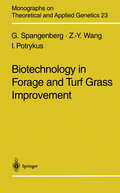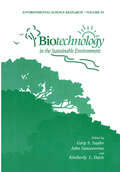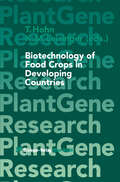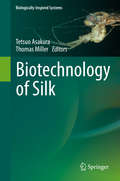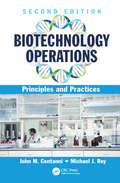- Table View
- List View
Biotechnology in Flavor Production
by Daphna Havkin-Frenkel Faith C. BelangerBiotechnology can deliver complex flavors both as fermentation products and single constituents. Recent developments in transgenic research have spawned numerous studies in the use of metabolic engineering of biosynthetic pathways to produce high-value secondary metabolites that can enhance the flavors of food products. Biotechnology is also playing an increasingly important role in the breeding of food crops for enhanced flavor. This book provides a unique overview of the current state of the art of flavor production through biotechnology, examining the principles and current methods of producing flavors from plants and other organisms. Chapters are included on plant tissue culture, genetic engineering of plants for flavor improvement and genetic engineering of bacteria and fungi for flavor improvement of fermented beverages and dairy products. The book is directed at food scientists and technologists in the food and flavour industries as well as academics and ingredients suppliers.
Biotechnology in Flavor Production
by Daphna Havkin-Frenkel Nativ DudaiThroughout history, human beings have sought ways to enhance the flavor of the foods they eat. In the 21st century, biotechnology plays an important role in the flavor improvement of many types of foods. This book covers many of the biotechnological approaches currently being applied to flavor enhancement. The contribution of microbial metabolism to flavor development in fermented beverages and dairy products has been exploited for thousands of years, but the recent availability of whole genome sequences of the yeasts and bacteria involved in these processes is stimulating targeted approaches to flavor enhancement. Chapters discuss recent developments in the flavor modification of wine, beer, and dairy products through the manipulation of the microbial species involved. Biotechnological approaches to the production of specific flavor molecules in microbes and plant tissue cultures, and the challenges that have been encountered, are also covered, along with the metabolic engineering of food crops for flavor enhancement - also a current area of research. Biotechnology is also being applied to crop breeding through marker-assisted selection for important traits, including flavor, and the book looks at the application of the biotechnological approach to breeding for enhanced flavor in rice, apple, and basil. These techniques are subject to governmental regulation, and this is addressed in a dedicated chapter. This updated second edition features five brand new chapters, and the topics covered in the book will be of interest to those in the flavor and food industries as well as to academic researchers interested in flavors.
Biotechnology in Flavor Production
by Daphna Havkin-Frenkel Nativ DudaiThroughout history, human beings have sought ways to enhance the flavor of the foods they eat. In the 21st century, biotechnology plays an important role in the flavor improvement of many types of foods. This book covers many of the biotechnological approaches currently being applied to flavor enhancement. The contribution of microbial metabolism to flavor development in fermented beverages and dairy products has been exploited for thousands of years, but the recent availability of whole genome sequences of the yeasts and bacteria involved in these processes is stimulating targeted approaches to flavor enhancement. Chapters discuss recent developments in the flavor modification of wine, beer, and dairy products through the manipulation of the microbial species involved. Biotechnological approaches to the production of specific flavor molecules in microbes and plant tissue cultures, and the challenges that have been encountered, are also covered, along with the metabolic engineering of food crops for flavor enhancement - also a current area of research. Biotechnology is also being applied to crop breeding through marker-assisted selection for important traits, including flavor, and the book looks at the application of the biotechnological approach to breeding for enhanced flavor in rice, apple, and basil. These techniques are subject to governmental regulation, and this is addressed in a dedicated chapter. This updated second edition features five brand new chapters, and the topics covered in the book will be of interest to those in the flavor and food industries as well as to academic researchers interested in flavors.
Biotechnology in Forage and Turf Grass Improvement (Monographs on Theoretical and Applied Genetics #23)
by German Spangenberg Zeng-Yu Wang Ingo PotrykusBiotechnology in Functional Foods and Nutraceuticals
by Debasis Bagchi Francis C. Lau Dilip K. GhoshModern food biotechnology is now a billion-dollar industry, producing functional foods and nutraceuticals that offer a whole host of increased health benefits, including prevention against illness, and chronic and degenerative conditions. Written by a team of top-tier researchers and scientists from around the world, Biotechnology in Functional Foo
Biotechnology in India - Reworking A Strategy
by George John Amulya K. PandaThis book examines the progress in the biotechnology sector in India towards knowledge and innovation driven Bioeconomy. The chapters of the book review different genome editing techniques and the GM crops focusing on the emerging potential in agricultural biotechnology. Chapters on Vaccines and AI in healthcare unfold huge opportunities in medical biotechnology. The book covers the advances in biotechnology towards delivering important benefits of healthcare, particularly through the pharmaceutical industry focusing on new healthcare interventions and delivering innovations. Further, it explores the major opportunities in industrial biotechnology related to bio-pharma, biorefinery, fermentation biotechnology, and growing synergies between industry-academia. Toward the end, the book also reviews the genetic regulation and the critical role of HRD. In summary, the book emphasizes on India as a strong bio-manufacturing hub for innovative, affordable and accessible products for the society and also for global markets while describing the sector wise strategies required.
Biotechnology in Industrial Waste Treatment and Bioremediation
by Gretchen Smith Robert F. HickeyBiotechnology in Industrial Waste Treatment and Bioremediation addresses the increasingly important topic of waste treatment. Focusing on microbiological degradation of contaminants, it offers a representative picture of the current status of environmental biotechnology and lays a solid foundation of the methods and applications of bioremediation. The expert presentations of case studies in this new book demonstrate successful treatment schemes and technologies meeting regulatory standards. These case studies represent an international cross-section of strategies for developing and implementing the evolving technologies of bioremediation. Biotechnology in Industrial Waste Treatment and Bioremediation examines the primary waste streams, including air, water, soils, and sediments, and explores specific treatment methodologies for industrial and environmental contaminants. This broad and unique coverage allows treatment firms and regulatory authorities to determine and develop appropriate treatment strategies for site-specific problems of waste remediation. The observations and successful field applications compiled in Biotechnology in Industrial Waste Treatment and Bioremediation make it an excellent reference for understanding, evaluating, developing, and operating efficient and cost-effective full-scale treatment systems.
Biotechnology in Industrial Waste Treatment and Bioremediation
by Gretchen Smith Robert F. HickeyBiotechnology in Industrial Waste Treatment and Bioremediation addresses the increasingly important topic of waste treatment. Focusing on microbiological degradation of contaminants, it offers a representative picture of the current status of environmental biotechnology and lays a solid foundation of the methods and applications of bioremediation. The expert presentations of case studies in this new book demonstrate successful treatment schemes and technologies meeting regulatory standards. These case studies represent an international cross-section of strategies for developing and implementing the evolving technologies of bioremediation. Biotechnology in Industrial Waste Treatment and Bioremediation examines the primary waste streams, including air, water, soils, and sediments, and explores specific treatment methodologies for industrial and environmental contaminants. This broad and unique coverage allows treatment firms and regulatory authorities to determine and develop appropriate treatment strategies for site-specific problems of waste remediation. The observations and successful field applications compiled in Biotechnology in Industrial Waste Treatment and Bioremediation make it an excellent reference for understanding, evaluating, developing, and operating efficient and cost-effective full-scale treatment systems.
Biotechnology in Medical Sciences
by Firdos Alam KhanAs the field of medical biotechnology grows with new products and discoveries, so does the need for a holistic view of biotechnology in medicine. Biotechnology in Medical Sciences fulfills that need by delivering a detailed overview of medical biotechnology as it relates to human diseases and epidemiology, bacteriology and antibiotics, virology and
Biotechnology in South Korea, Taiwan and Singapore
by Robert YuanThis study examines biotechnology in the newly industrializing countries of Singapore, South Korea and Taiwan. Until recently, these countries have been known mainly for their first tentative moves into high technology. Government policy, research organizations and companies are covered.
Biotechnology in Space (SpringerBriefs in Space Life Sciences)
by Günter Ruyters Christian Betzel Daniela GrimmThis book summarizes the early successes, drawbacks and accomplishments in cell biology and cell biotechnology achieved by the latest projects performed on the International Space Station ISS. It also depicts outcomes of experiments in tissue engineering, cancer research and drug design and reveals the chances that research in Space offers for medical application on Earth.This SpringerBriefs volume provides an overview on the latest international activities in Space and gives an outlook on the potential of biotechnological research in Space in future. This volume is written for students and researchers in Biomedicine, Biotechnology and Pharmacology and may specifically be of interest to scientists with focus on protein sciences, crystallization, tissue engineering, drug design and cancer research.
Biotechnology in Surgery (Updates in Surgery)
by Alfonso Barbarisi Paolo Bechi Paolo Innocenti Carlo A. Redi Francesco RossoThe 20th century has finished, the century when surgery took huge steps forward thanks to progress in technology. Now we have entered the "century of biotechnologies", which will not only generate progress in surgery, but also lead to a real "cultural revolution" that will completely change approaches to solving different problems in medicine. The aim of this book is to bring surgeons closer to biotechnologies and to overcome the cultural gap dividing them from these new approaches. Biotechnologies are already proposed and used at different levels in surgical practice: in diagnostic technique, enabling practitioners to identify diseases at an early stage and follow their molecular modification over time; and in tissue engineering, where the use of "smart scaffolds" offers a possible answer to increasing demand for biocompatible tissues and organs in transplantation surgery. This volume focuses on the emerging field of stem cells, analyzing both their role as possible players in originating and perpetuating cancer – "cancer stem cells" – and, conversely, their extraordinary therapeutical potential. An additional section is dedicated to the evaluation and application of derived molecular factors that can enhance the physiological processes that are fundamentally important in surgery, such as hemostasis and wound healing. Surgeons have always been technologists, in the sense that since surgery began they have always needed technology, beginning with a scalpel and surgical instruments. They have always cooperated with technologists. However, in the new century, the first one of the millennium, a rapid increase in knowledge that is outside the realm of the surgeon’s traditional technological training is imposing itself – hence the aim of this book. It is now urgent to encourage surgeons to embrace this knowledge (biotechnology) with confidence. By its very nature, biotechnology is completely different from the technologies used so far, because it escapes the senses of sight and touch, which up to now have been the essence of the surgeon’s work. The cellular and molecular dimensions of biotechnologies are still far removed from most of the recent advances in modern surgical techniques. A common language between surgeons and biotechnologists will create further, revolutionary, progress in surgical sciences in the twenty-first century.
Biotechnology in Tall Fescue Improvement
by Michael J. KasperbauerThis one-of-a-kind publication focuses on the improvement of the feed value of tall fescue and further extension of its adaptability under various environmental stresses. This fascinating work comprehensively explains cell and tissue culture methods which are used to establish somatic cell cultures, select among cells, and regenerate plants with the genetic characteristics of the selected cells. This up-to-date volume includes information on cultural haploid plants from immature pollen grains. It also evaluates the plants under various environmental stresses to identify genotypes with superior characteristics. This book also features research data on somatic tissue culture methods and doubled haploids. Biotechnology in Tall Fescue Improvement is an indispensable resource and useful text for all those involved with agronomy, plant physiology, horticultural science, crop science, and botany.
Biotechnology in Tall Fescue Improvement
by Michael J. KasperbauerThis one-of-a-kind publication focuses on the improvement of the feed value of tall fescue and further extension of its adaptability under various environmental stresses. This fascinating work comprehensively explains cell and tissue culture methods which are used to establish somatic cell cultures, select among cells, and regenerate plants with the genetic characteristics of the selected cells. This up-to-date volume includes information on cultural haploid plants from immature pollen grains. It also evaluates the plants under various environmental stresses to identify genotypes with superior characteristics. This book also features research data on somatic tissue culture methods and doubled haploids. Biotechnology in Tall Fescue Improvement is an indispensable resource and useful text for all those involved with agronomy, plant physiology, horticultural science, crop science, and botany.
Biotechnology in the Sustainable Environment (Environmental Science Research #54)
by Gary S. Sayler John Sanseverino Kimberly L. DavisProceedings of a Conference held in Knoxville, Tennessee, April 14-17 1996
Biotechnology of Bioactive Compounds: Sources and Applications
by Vijai Kumar Gupta Maria G. Tuohy Anthonia O'Donovan Mohtashim LohaniBioactive compounds play a central role in high-value product development in the chemical industry. Bioactive compounds have been identified from diverse sources and their therapeutic benefits, nutritional value and protective effects in human and animal healthcare have underpinned their application as pharmaceuticals and functional food ingredients. The orderly study of biologically active products and the exploration of potential biological activities of these secondary metabolites, including their clinical applications, standardization, quality control, mode of action and potential biomolecular interactions, has emerged as one of the most exciting developments in modern natural medicine. Biotechnology of Bioactive Compounds describes the current stage of knowledge on the production of bioactive compounds from microbial, algal and vegetable sources. In addition, the molecular approach for screening bioactive compounds is also discussed, as well as examples of applications of these compounds on human health. The first half of the book comprises information on diverse sources of bioactive compounds, ranging from microorganisms and algae to plants and dietary foods. The second half of the book reviews synthetic approaches, as well as selected bioactivities and biotechnological and biomedical potential. The bioactive compounds profiled include compounds such as C-phycocyanins, glycosides, phytosterols and natural steroids. An overview of the usage of bioactive compounds as antioxidants and anti-inflammatory agents, anti-allergic compounds and in stem cell research is also presented, along with an overview of the medicinal applications of plant-derived compounds. Biotechnology of Bioactive Compounds will be an informative text for undergraduate and graduate students of bio-medicinal chemistry who are keen to explore the potential of bioactive natural products. It also provides useful information for scientists working in various research fields where natural products have a primary role.
Biotechnology of Bioactive Compounds: Sources and Applications
by Mohtashim Lohani Maria G. Tuohy Vijai Kumar Gupta Anthonia O'DonovanBioactive compounds play a central role in high-value product development in the chemical industry. Bioactive compounds have been identified from diverse sources and their therapeutic benefits, nutritional value and protective effects in human and animal healthcare have underpinned their application as pharmaceuticals and functional food ingredients. The orderly study of biologically active products and the exploration of potential biological activities of these secondary metabolites, including their clinical applications, standardization, quality control, mode of action and potential biomolecular interactions, has emerged as one of the most exciting developments in modern natural medicine. Biotechnology of Bioactive Compounds describes the current stage of knowledge on the production of bioactive compounds from microbial, algal and vegetable sources. In addition, the molecular approach for screening bioactive compounds is also discussed, as well as examples of applications of these compounds on human health. The first half of the book comprises information on diverse sources of bioactive compounds, ranging from microorganisms and algae to plants and dietary foods. The second half of the book reviews synthetic approaches, as well as selected bioactivities and biotechnological and biomedical potential. The bioactive compounds profiled include compounds such as C-phycocyanins, glycosides, phytosterols and natural steroids. An overview of the usage of bioactive compounds as antioxidants and anti-inflammatory agents, anti-allergic compounds and in stem cell research is also presented, along with an overview of the medicinal applications of plant-derived compounds. Biotechnology of Bioactive Compounds will be an informative text for undergraduate and graduate students of bio-medicinal chemistry who are keen to explore the potential of bioactive natural products. It also provides useful information for scientists working in various research fields where natural products have a primary role.
Biotechnology of Extremophiles: Advances and Challenges (Grand Challenges in Biology and Biotechnology #1)
by Pabulo H. RampelottoAimed at research scientists and biotechnologists, this book is an essential reading for those working with extremophiles and their potential biotechnological application. Here, we provide a comprehensive and reliable source of information on the recent advances and challenges in different aspects of the theme. Written in an accessible language, the book is also a recommended as reference text for anyone interested in this thriving field of research. Over the last decades, the study of extremophiles has provided ground breaking discoveries that challenge our understanding of biochemistry and molecular biology. In the applied side, extremophiles and their enzymes have spawned a multibillion dollar biotechnology industry, with applications spanning biomedical, pharmaceutical, industrial, environmental, and agricultural sectors. Taq DNA polymerase (which was isolated from Thermus aquaticus from a geothermal spring in Yellowstone National Park) is the most well-known example of the potential biotechnological application of extremophiles and their biomolecules. Indeed, the application of extremophiles and their biologically active compounds has opened a new era in biotechnology. However, despite the latest advances, we are just in the beginning of exploring the biotechnological potentials of extremophiles.
Biotechnology of Food Crops in Developing Countries (Plant Gene Research)
by T. Hohn K. M. LeisingerRecent advances in gene technology, plant transformation, and the growing knowledge of DNA sequences of plants as well as of their most important parasites and symbionts offer many interesting prospects for the breeding of new crop varieties. This was not only recognized by the major seed companies, but also by the governments of developing countries and by worldwide foundations supporting their agriculture. The know-how gained by the seed companies on crops important for the agricultural industry in developed countries could easily be provided for free to the international and national organizations dedicated to development of crops important in the third world. Results obtained worldwide become easily available to everybody through the scientific literature. Likewise, agricultural research in, e.g., the USA or Europe profits from the natural plant gene pool available in the third world. All this definitely provides for the possibility of fast change, new prosperity and security of food supply in the whole world, if properly applied. The fast development also asks for ethical and sociopolitical considerations, whereby not doing the right can be as much a mistake as doing the wrong.
Biotechnology of Lactic Acid Bacteria: Novel Applications
by Fernanda Mozzi Rául R. RayaLactic acid bacteria (LAB) have historically been used as starter cultures for the production of fermented foods, especially dairy products. Over recent years, new areas have had a strong impact on LAB studies: the application of "omics" tools; the study of complex microbial ecosystems, the discovery of new LAB species, and the use of LAB as powerhouses in the food and medical industries. This second edition of Biotechnology of Lactic Acid Bacteria: Novel Applications addresses the major advances in the fields over the last five years. Thoroughly revised and updated, the book includes new chapters. Among them: The current status of LAB systematics; The role of LAB in the human intestinal microbiome and the intestinal tract of animals and its impact on the health and disease state of the host; The involvement of LAB in fruit and vegetable fermentations; The production of nutraceuticals and aroma compounds by LAB; and The formation of biofilms by LAB. This book is an essential reference for established researchers and scientists, clinical and advanced students, university professors and instructors, nutritionists and food technologists working on food microbiology, physiology and biotechnology of lactic acid bacteria.
Biotechnology of Lactic Acid Bacteria: Novel Applications
by Fernanda Mozzi Raúl R. Raya Graciela M. VignoloLactic acid bacteria (LAB) have historically been used as starter cultures for the production of fermented foods, especially dairy products. Over recent years, new areas have had a strong impact on LAB studies: the application of "omics" tools; the study of complex microbial ecosystems, the discovery of new LAB species, and the use of LAB as powerhouses in the food and medical industries. This second edition of Biotechnology of Lactic Acid Bacteria: Novel Applications addresses the major advances in the fields over the last five years. Thoroughly revised and updated, the book includes new chapters. Among them: The current status of LAB systematics; The role of LAB in the human intestinal microbiome and the intestinal tract of animals and its impact on the health and disease state of the host; The involvement of LAB in fruit and vegetable fermentations; The production of nutraceuticals and aroma compounds by LAB; and The formation of biofilms by LAB. This book is an essential reference for established researchers and scientists, clinical and advanced students, university professors and instructors, nutritionists and food technologists working on food microbiology, physiology and biotechnology of lactic acid bacteria.
Biotechnology of Lignocellulose: Theory and Practice
by Hongzhang ChenThis book presents and summarizes the new thoughts, new methods and new achievements that have emerged in the biotechnology of lignocellulose in recent years. It proposes new concepts including the primary refining, fractionation, multi-level utilization and selective structural separation of lignocellulose, etc. By approaching lignocellulose as a multi-level resource, biotechnology could have a significant effect on ecological agriculture, bio-energy, the chemical and paper making industries, etc., ultimately establishing distinctive eco-industrial parks for lignocellulose. Additionally, this book provides systematic research methods for the biotechnology of lignocellulose including investigation methods for the primary refining of lignocellulose, for microbial degradation and enzymatic hydrolysis, for cellulose fermentation and for lignocellulose conversion processes. It offers an excellent reference work and guide for scientists engaging in research on lignocellulose. Dr. Hongzhang Chen is a Professor at the Institute of Process Engineering of the Chinese Academy of Sciences, Beijing, China.
Biotechnology of Natural Products
by Wilfried Schwab Bernd Markus Lange Matthias WüstThis text comprehensively covers the analysis, enzymology, physiology and genetics of valuable natural products used in the food industry that are attractive targets for biotechnological production. The focus is on the recent advances made to achieve this goal. This unique work is the first book to focus on biotechnological production of important natural products in food additives, fragrances and flavorings, and other bioactive compounds in food. The chapters offer a deep insight into modern research and the development of low molecular weight natural products. Biotechnology of Natural Products covers products in the Phenolic, Terpenoid, and Alkaloid categories, providing a full overview of the biotechnology of food additives and other low molecular weight natural products. Gene clustering and the evolution of pathways are covered, as well as future perspectives on the topic. Due to limited oil resources and increasing consumer demand for naturalness, bioprocesses are increasingly needed to meet these requirements. Novel sophisticated technologies have facilitated the elucidation of new chemical molecules, their biosynthetic pathways and biological functions. This book provides researchers with a full overview of the technologies and processes involved in the biotechnology of natural products.
Biotechnology of Silk (Biologically-Inspired Systems #5)
by Tetsuo Asakura Thomas MillerThis book is a snapshot of the current state of the art of research and development on the properties and characteristics of silk and their use in medicine and industry. The field encompasses backyard silk production from ancient time to industrial methods in the modern era and includes an example of efforts to maintain silk production on Madagascar. Once revered as worth its weight in gold, silk has captured the imagination from its mythical origins onwards. The latest methods in molecular biology have opened new descriptions of the underlying properties of silk. Advances in technological innovation have created silk production by microbes as the latest breakthrough in the saga of silk research and development. The application of silk to biomaterials is now very active on the basis of excellent properties of silks including recombinant silks for biomaterials and the accumulated structural information.
Biotechnology Operations: Principles and Practices, Second Edition
by John M. Centanni Michael J. RoyThis book describes seven areas in the field of biotechnology operations as practiced by biopharmaceutical firms and nonprofit institutions. Revisions focus upon changes that have occurred in several areas over the past six years, with emphasis on regulatory, biomanufacturing, clinical and technical information, along with processes and guidlines that have added to the discipline. Examples are increased for new technical fields such as cell and tissue engineering. Further, illustrations or figures are added to each chapter to emphasize particular points.


